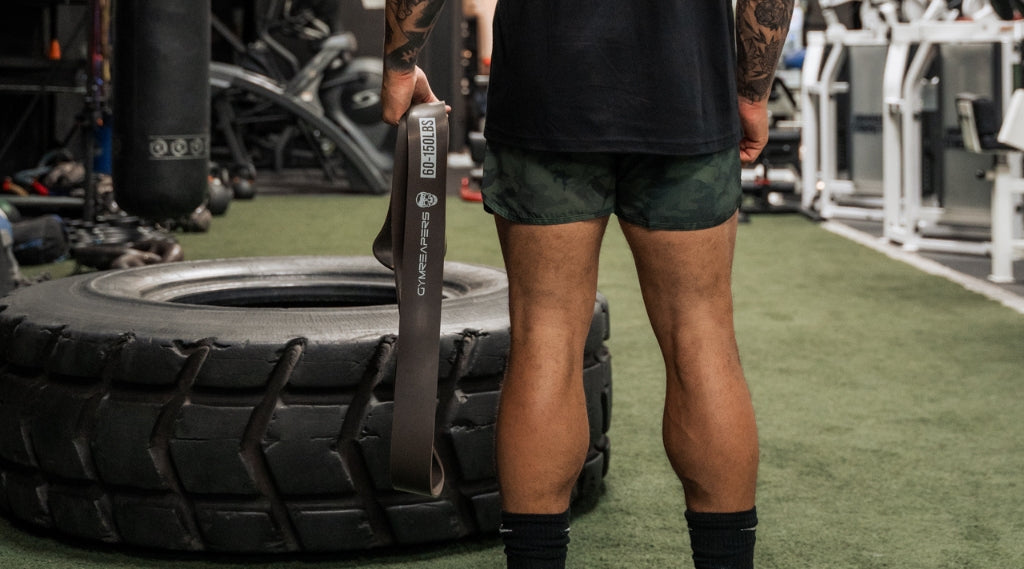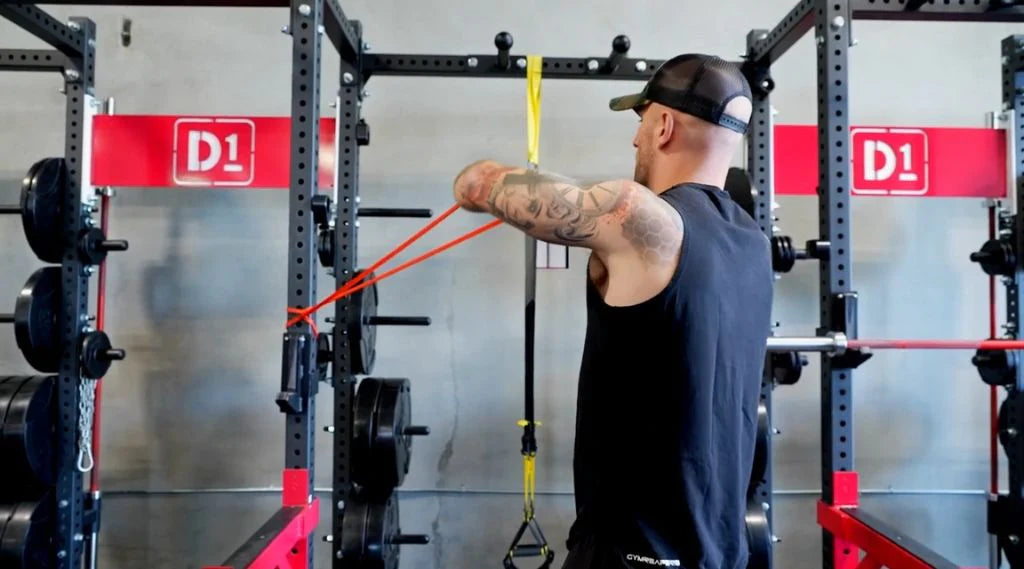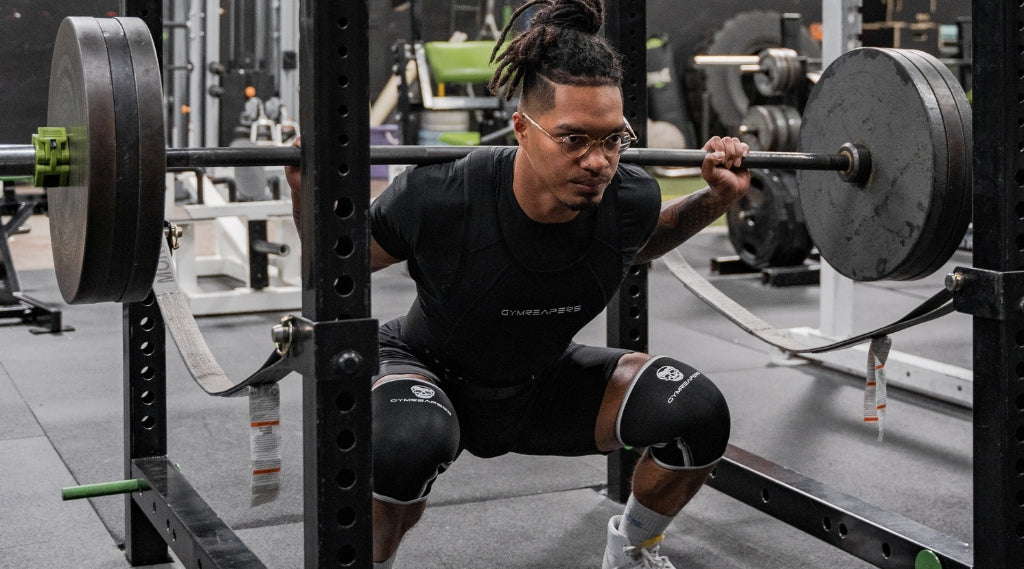If you want to take your calf training to the next level so that you can finally wear shorts to the gym with pride, then incorporating bands into your workout routine is the way to go.
Some of the best resistance band calf exercises include banded ankle pumps, banded calf raises, soleus raises, and marching with calf raises. Adding these exercises into your calf routine is a great way to stimulate the main 2 muscles that make up your calves and encourage muscle gain.
In this article, I'll explain the science behind calf training, share 6 of my personal favorite banded calf exercises, teach you how to perform the movements properly and give you a sample calf workout that you can try today.
Key Takeaways
Anatomy of the Calf Muscles

The calf is the primary group of muscles that make up your lower leg and is composed of 2 major muscles. These muscles make up the portion of your leg between your knee and your ankle, on the posterior (back) of your leg.
Your calves are primarily responsible for:
- Plantar flexion (pointing the foot downwards).
- Aids your legs and feet in running and jumping activities.
- Can help flex your knee, although this is mainly the job of your hamstrings.
The calf muscles include the gastrocnemius and the soleus.
Gastrocnemius
The Gastrocnemius is the larger of your two calf muscles. It is very powerful, and functions in movements that require going up onto your toes, like running and jumping.
It originates from the bottom of the femur, which is the thigh bone, and inserts by the Achilles tendon on the back of the heel.
It has two “heads” which are primarily what people think of when they are training to develop their calf muscles. These heads are simply called the medial (inside) and lateral (outside) heads.
Soleus
The soleus muscle is the smaller of the two calf muscles, and it is located lower and deeper than the gastrocnemius. It functions similarly to the gastrocnemius and is targeted in all of the same movements.
Unlike the gastrocnemius, the soleus originates below the knee at the top of the fibula and upper part of the tibia (your shin bones). It then also inserts into the back of the heel via the Achilles tendon, with the gastrocnemius.
Targeting One Calf Muscle Over the Other
It is interesting to note that your gastrocnemius and soleus are referred to as “synergists,” which means that they mainly serve the same function. However, you can manipulate your training to target one muscle more than the other based on the degree of knee flexion you have.
Since the gastrocnemius crosses both the knee and ankle joint, while the soleus only crosses the ankle, your gastrocnemius is primarily active during standing calf raises, whereas your soleus is more heavily recruited when doing bent knee calf raises (seated).
Plenty of scientific studies back up this fact, including Baumbach et al (2014) and Lauber et al (2014).
Later on, I’ll share my top 6 banded calf exercises that work both of these muscles to maximize your calf training and development.
Benefits of Training the Calves With Bands

The benefits of training the calves with bands include:
Using bands to perform some of the exercises below is a great way to very quickly warm up your calves and Achilles tendon. Getting just a bit of blood flow in will help you perform optimally, and will keep you healthy in the long run.
This keeps them working throughout the entire range of motion, which will increase time under tension, increase muscle activation, and encourage more growth.
Since your band will be the most stretched out at the top of your range of motion in most of these exercises, you will be working harder to complete each rep. This will increase your pump and help you stimulate more growth.
With these exercises, you can effectively train your calves from anywhere, using only a resistance band (which is extremely lightweight and compact).
When you use bands for resistance, the tension is not so heavy that you start performing the movements incorrectly but you’ll get a much better stimulus than doing endless bodyweight calf raises.
6 Best Calf Exercises With Bands
The 6 best calf exercises to perform with bands include:
1. Banded Ankle Pumps
This is a great exercise that you can perform seated on the ground to target your gastrocnemius, and soleus, and even improve your ankle mobility. I prefer doing banded ankle pumps one leg at a time to focus on each calf separately.
How To
- Begin seated on the ground with your right knee bent and your right foot on the floor. Your left leg should be extended straight. Loop a band around the ball of your left foot.
- Holding the other end of the band in your hands, press the toes of your left foot away from you. Pretend you’re pumping a gas pedal.
- Pause for a few seconds with your foot extended like this. Fight the urge to let the band bring your toes back towards you as you pause.
- Bring your toes back towards you so that they are facing the ceiling. Do this slowly and controlled, fighting the band tension.
- Perform the same on your other foot.
Pro tip: Make sure that when you’re pressing the gas pedal, you keep your foot straight rather than letting your foot roll to one side or the other. Depending on your ankle mobility, this may be difficult.
2. Banded Standing Single Leg Calf Raise
This is a great banded variation of the traditional standing single-leg calf raise. It is a staple for a reason, as you will feel a great burn in both of your calf muscles. Using a band increases the difficulty of the traditional calf raise so that you can build strength and muscle more effectively.
How To
- Step on the band with one foot. Make sure that the band is under the ball of your foot, and not your heel.
- Keep your other foot off of the band and instead hold this foot up in the air so that you’re loading one leg at a time.
- Grab the band with both hands, raise the band up, and place it on your shoulders. If it does not stretch this far, just hold it in your hands high enough that there is noticeable tension.
- Balancing on the foot that is pinning the band down, raise your heel and bring yourself up on your toes.
- Stay in the top position for a moment, flexing your calf muscles and fighting the band tension.
- Slowly lower yourself back to start (foot flat on the ground).
- Repeat for reps, and then switch legs.
Pro tip: For a deeper stretch, perform this movement on an elevated surface like the first step of your stairs. This will allow you to drop your heel lower than where the floor would be, and get a better stretch in the bottom position.
3. Banded Seated Calf Raise
The first two movements have been gastrocnemius dominant, whereas this exercise will target your soleus muscle. The soleus is emphasized in this exercise because your knees will be bent at approximately 90 degrees.
How To
- Sit in a chair that allows you to place both feet flat on the ground with your knees bent at approximately 90 degrees.
- Step on a resistance band with both feet, placing it underneath the balls of your feet.
- Cinch the band around your knees in a way that it will fight you when you raise your heels up and go on your toes.
- Perform the calf raise by lifting your heels off the floor as high as you can, pausing for a second at the top against the band resistance, and then slowly lowering your heels back to the floor.
Pro tip: If your band is too loose to feel a significant burn when it is pinned below your feet, you can loop it once so that the band has a smaller circumference. This will effectively cut the band in half and should give it much more tension.
4. Banded Soleus Raise
A banded soleus raise is similar to the seated calf raise listed above but requires a smaller mini band (otherwise known as a hip band) that you step through and loop around your thighs to perform the movement.
How To
- Stand with your feet at hip-width apart. Make sure you have a flat back and brace your core.
- Loop a resistance band above your knees. You should feel it trying to pull your knees together, and it should be tight enough that you actively have to work to keep your knees apart (without it being impossible).
- Push your hips back and squat down until your knees are bent to about 90 degrees.
- Holding this squat, slowly raise yourself onto the balls of your feet. Essentially doing a calf raise in a squat position.
- Pause at the top and feel your calves contract.
- Slowly lower your heels back to the floor and then repeat.
Pro tip: If you don’t have a mini band, you can loop your longer resistance band multiple times until it is a small enough circle that you can loop it around your thighs and it will provide resistance.
Also, if you struggle to maintain your balance on this exercise, feel free to hold onto a stable surface.
5. Banded March with Calf Raise
This is a great exercise that not only works your calf muscles but will elevate your heart rate and serve as a form of cardio. It’s another exercise that would best be performed with a mini band, rather than a full-size loop band.
Note that in the video, this lifter does not perform the calf raise portion and is instead focused on working their psoas muscle in their hip. This is a great variation where your calves can simply be targeted by pausing at the top of the movement and performing a single leg calf raise against band tension.
How To
- Start by standing tall with your feet hip-width apart.
- Loop a mini resistance band around the balls of your feet.
- Raise one knee up towards the ceiling.
- While doing this, come up onto the balls of your other foot.
- Pause in this position for a moment and try to contract your calf on your foot that is on the ground. Don’t let the band pull your other foot back down.
- Return to the start position and then switch sides, alternating back and forth.
Pro tip: if you have trouble balancing, perform this exercise near a wall so that you can put your hands on it for support.
6. Banded Tibialis Pull
This final exercise isn’t a calf exercise but should be included in your calf workouts because it helps to maintain the balance between the lower leg muscles.
This exercise targets the lower leg muscle on the front of your shin, your tibialis. A strong tibialis is crucial for a strong and healthy lower leg, and this exercise is a great way to make sure it is not neglected.
How To
- This exercise will feel like the opposite of the banded ankle pumps.
- Tie your band around a stable anchor surface (pole, squat rack, heavy dumbbell, etc). Make sure that it is only about 6-12 inches off the ground.
- Sit on the ground and loop the band around the top of your foot, near your toes.
- Make sure you are far enough away from your anchor point that the band is taut when your toes are pointed to the ceiling, and you can feel the band trying to pull your toes away from you.
- Keeping the same pace as you would for your banded ankle pumps, slowly let the band lower your toes down (away from you), pause, and then fight the band and bring your toes back up to face the ceiling.
- Hold this position for a second before performing another rep. You should feel a contraction in the muscles on your shin.
Pro tip: if you don’t train your tibialis frequently, you might have side-to-side imbalances. To sort this out, start with your weaker leg and then be sure to only perform the same amount of reps with your strong leg that you could do with your weaker one.
Sample Calf Workout Routine With Bands
Now that you’re familiar with the best banded calf exercises, it’s time to combine them into a program.
Here is an effective resistance band calf routine that you can do with some of the above exercises:
|
Exercise |
Sets |
Reps |
Rest |
Notes |
|
Banded Standing Single Leg Calf Raises |
4 |
15-20 |
60 seconds |
Go close to failure on your sets here |
|
Banded Tibialis Pull |
3 |
8-12 |
60 seconds |
Do these one leg at a time, start with your weaker leg. |
|
Banded Ankle Pumps |
3 |
15 |
90 seconds |
Your calves should be fatigued, so you can rest longer. Make sure to get a good contraction |
|
Banded Soleus Raise |
3 |
15-20 |
60 seconds |
Slow and controlled, do these both legs at a time. |
Note that I did not include all 6 exercises. This is because some of them are very similar in how they target the calves.
It would be redundant to perform all of them on the same day, and they are better viewed as options that you can swap in and out depending on your training preferences.
Best Bands For Training Your Calves
My favorite bands for calf exercises are the Gymreapers Military Resistance Band Set because the set comes with bands that range in resistance from 20-150 lbs to satisfy every strength level.

When looking to incorporate banded exercises into your calf training, I highly recommend purchasing multiple bands so that you have different levels of resistance to choose from.
Depending on your exercises and if you are performing them unilaterally or not, or standing, crouched, or seated, you may find that you’ll need to be swapping out bands frequently.
Having a full set of bands will be the best way to make sure you are properly equipped as you get stronger, and buying them as a pack is a great way to save money.

In addition to the longer loop bands, the Gymreapers Hip Bands will be very helpful for exercises like the Banded March and Soleus Raises, and the Gymreapers Floss Bands are perfect for banded ankle pumps and tibialis pulls.














Leave a comment
All comments are moderated before being published.
This site is protected by hCaptcha and the hCaptcha Privacy Policy and Terms of Service apply.